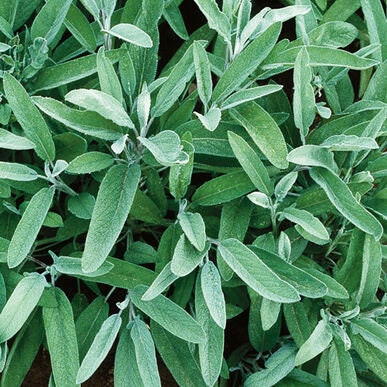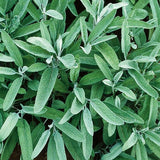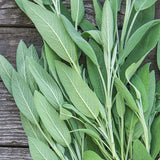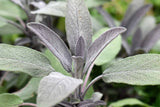Sage, Broadleaf Sage Seeds, Heirloom, NON GMOSage is a shrubby evergreen perennial that forms many side branches of velvety-textured, wrinkled, gray-green leaves about 2 inches long. Spikes of 1/2-inch violet, pink to white flowers appear in summer. Planting: Cover the seeds with 1/4 inch of fine soil. Keep moist until the seed starts to sprout. Once growing, transplant seedlings to be about 6 inches apart. Organic Sage seeds - also called Organic Broadleaf Sage or Common Sage - can be planted indoors or outdoors. An extremely flavorful and versatile herb, sage is commonly used to spice poultry, vegetables, stuffings, sausages, and many other foods. Sage is also an attractive perennial garden herb plant.Tops for seasoning poultry, stuffing, and sausage
Very attractive and fragrant foliage Can be trained as a bonsai This versatile herb can spice up recipes and provide wonderful foliage and aroma to the perennial or herb garden. Sage is a perennial herb that's often used for flavoring poultry, stuffing, sausage, lamb, pork, wild game, and many other foods. Its rough-textured, oval, fragrant leaves are very attractive, and sage plants can also provide an ornamental backdrop in flower beds and containers as well as cut and dried flower arrangements. Sage can even be trained as a bonsai. Growing 18-30 in. tall, sage is suitable for growing in containers.Sage is a great herb to dress up chicken, salmon, turkey, stuffing, soups, beans, and squash. It has a savory flavor. Pruning: Harvest as needed. Pinch the growing tips of your Sage plant several times during spring and early summer. This will produce a bushier plant and slow the formation of flower buds.How to Grow Sage WHEN TO PLANT SAGE SEEDS Plant indoors 6-8 weeks before the last frost of the season, or sow directly into the garden after the last frost of the season.WHERE TO PLANT SAGE SEEDS Plant in loamy soils that are well-drained and have access to full sun (6-8 hours of sunlight per day). Consistently wet soils will easily kill Sage. Sage prefers soils that are neutral in pH, but will tolerate a range between 6.6-7.6pH.HOW TO PLANT SAGE SEEDS Sow directly into damp soil via broadcasting seed and lightly covering seeds up to 1/8th of an inch deep. Keep the soil moist, but not soaked for up to 3 weeks to allow for the seed to germinate properly. As Sage seedlings grow, thin out until each plant is 12-18 inches apart. If started indoors, set out plants into the garden 12-18 inches apart from each other.HOW TO HARVEST SAGE Entire stems or individual leaves can be harvested at once. Both small and large leaves may be harvested, but smaller leaves are more flavorful while larger leaves are better suited to drying. Stems can be hung upside down in a dark, cool, dry place such as a garage to dry, or leaves can be refrigerated for fresh use. Be sure to leave some leaves behind to the plant can adequately recover.
Very attractive and fragrant foliage Can be trained as a bonsai This versatile herb can spice up recipes and provide wonderful foliage and aroma to the perennial or herb garden. Sage is a perennial herb that's often used for flavoring poultry, stuffing, sausage, lamb, pork, wild game, and many other foods. Its rough-textured, oval, fragrant leaves are very attractive, and sage plants can also provide an ornamental backdrop in flower beds and containers as well as cut and dried flower arrangements. Sage can even be trained as a bonsai. Growing 18-30 in. tall, sage is suitable for growing in containers.Sage is a great herb to dress up chicken, salmon, turkey, stuffing, soups, beans, and squash. It has a savory flavor. Pruning: Harvest as needed. Pinch the growing tips of your Sage plant several times during spring and early summer. This will produce a bushier plant and slow the formation of flower buds.How to Grow Sage WHEN TO PLANT SAGE SEEDS Plant indoors 6-8 weeks before the last frost of the season, or sow directly into the garden after the last frost of the season.WHERE TO PLANT SAGE SEEDS Plant in loamy soils that are well-drained and have access to full sun (6-8 hours of sunlight per day). Consistently wet soils will easily kill Sage. Sage prefers soils that are neutral in pH, but will tolerate a range between 6.6-7.6pH.HOW TO PLANT SAGE SEEDS Sow directly into damp soil via broadcasting seed and lightly covering seeds up to 1/8th of an inch deep. Keep the soil moist, but not soaked for up to 3 weeks to allow for the seed to germinate properly. As Sage seedlings grow, thin out until each plant is 12-18 inches apart. If started indoors, set out plants into the garden 12-18 inches apart from each other.HOW TO HARVEST SAGE Entire stems or individual leaves can be harvested at once. Both small and large leaves may be harvested, but smaller leaves are more flavorful while larger leaves are better suited to drying. Stems can be hung upside down in a dark, cool, dry place such as a garage to dry, or leaves can be refrigerated for fresh use. Be sure to leave some leaves behind to the plant can adequately recover.




